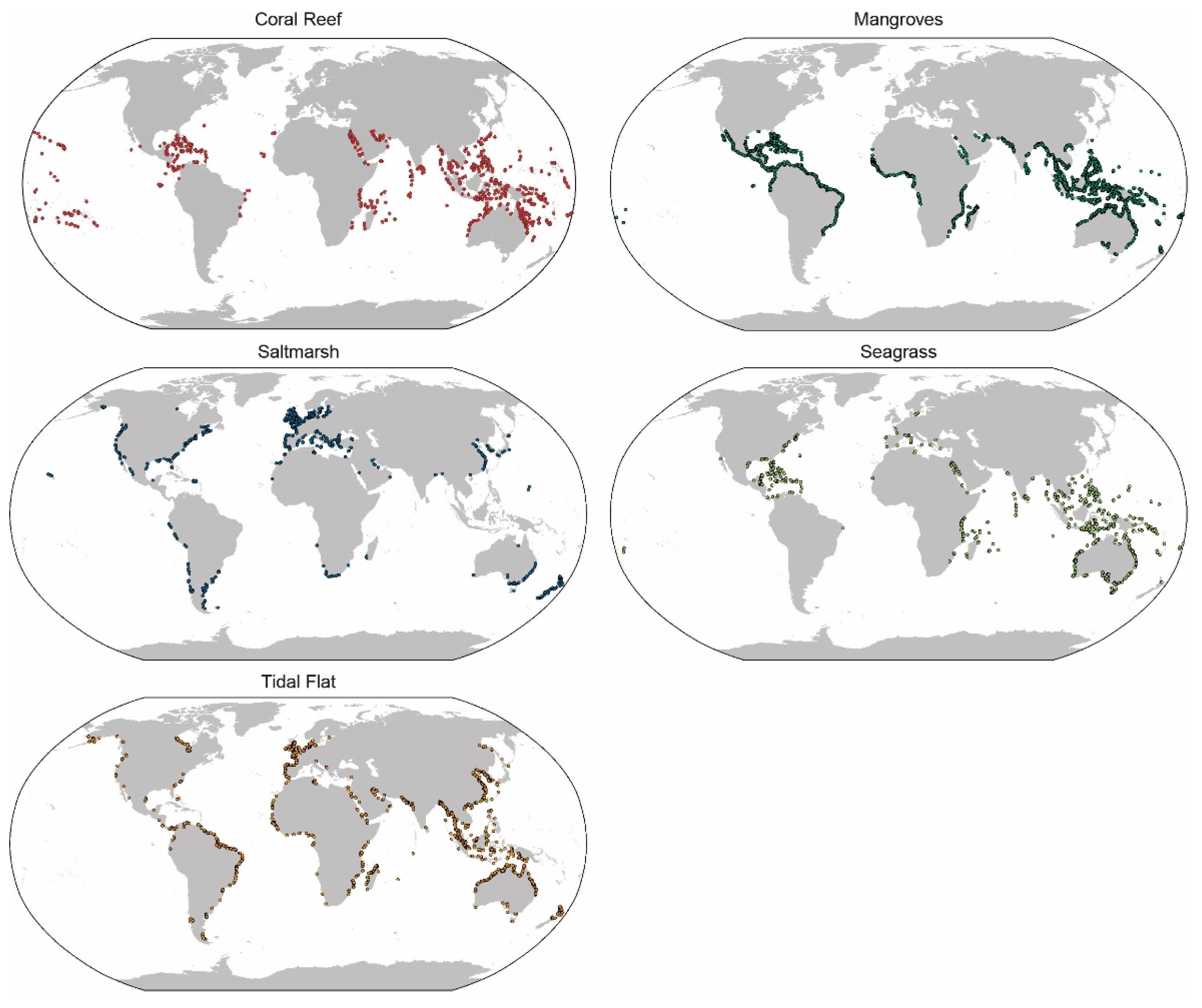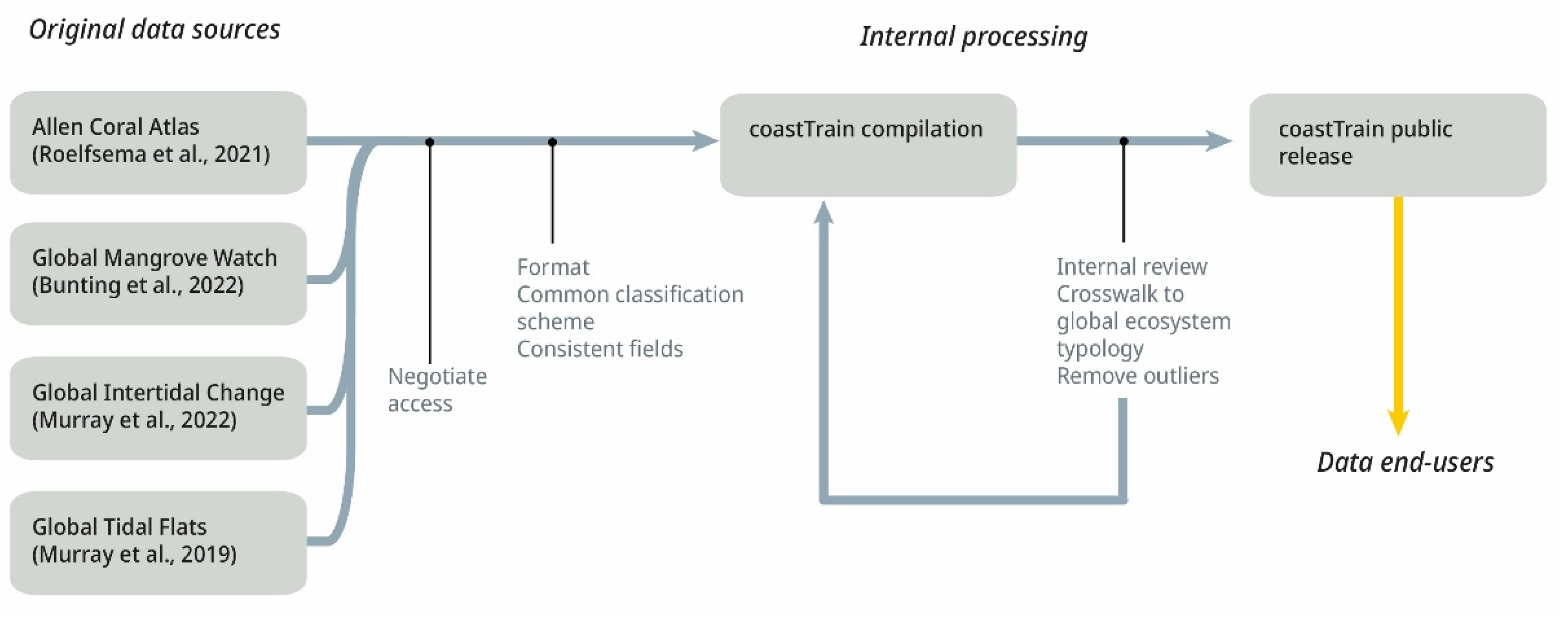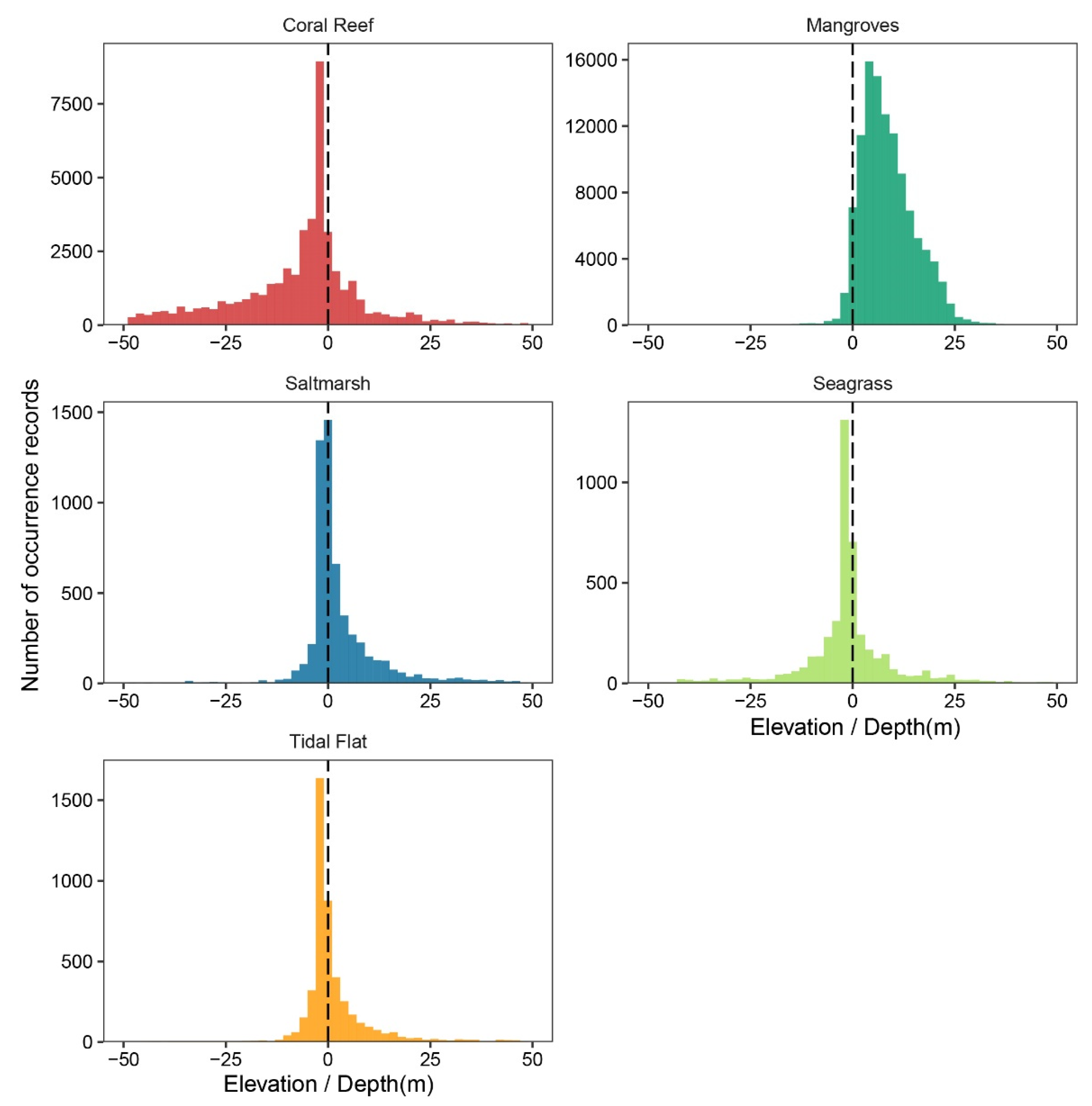coastTrain: A Global Reference Library for Coastal Ecosystems
Abstract
1. Summary
2. Data Description
2.1. Overview
2.2. Class Definitions
3. Method
3.1. Source Data
3.1.1. Allen Coral Atlas
3.1.2. Global Tidal Flats
3.1.3. Global Tidal Wetlands Change
3.1.4. Global Mangrove Watch
| Project | Project Description | Ecosystem Types | Number of Records | References |
|---|---|---|---|---|
| Allen Coral Atlas | Developed the first global map of shallow water tropical reefs using Planet satellite imagery and derived products. | Coral reef, Seagrass | 51,962 1980 | Allen Coral Atlas [32] Kennedy, et al. [19] Lyons, et al. [17] Roelfsema, et al. [7] Roelfsema, et al. [33] |
| Global Tidal Flats | Developed the first global maps of tidal flats for 11 time periods over the period 1984–2016 using Landsat Archive data. | Tidal flat Terrestrial other Permanent water | 1973 2658 2516 | Murray, et al. [10] Murray, et al. [23] |
| Global Tidal Wetland Change | Maps the global extent and the type and timing of change of tidal wetlands (tidal, flats, tidal marshes, mangroves) from 1999 to 2019 using Landsat Archive data. | Tidal flat Saltmarsh Mangrove Seagrass Rocky intertidal Kelp forest Terrestrial other Permanent water | 2722 5851 12,600 2689 56 12 6338 1748 | Murray, et al. [11] Murray, et al. [38] |
| Global Mangrove Watch | Provides open access geospatial data on the extent and change of mangroves from an analysis of JAXA L-band SAR (JERS-1, ALOS PALSAR and ALOS-2 PALSAR-2) data for 11 annual epochs between 1996 and 2020. | Mangrove | 100,000 | Bunting, et al. [12] Bunting, et al. [13] Bunting, et al. [21] |
| Total records | 193,105 |
3.2. Data Harmonization
3.3. Validation
4. User Notes
Usage Notes
- Point-occurrence training sets support a wide variety of spatial models. However, we recommend users visualize data records and familiarize themselves with the features that each point represents.
- Although coastTrain occurrence records are globally distributed (Figure 1), the aims of each source project may have limited their collection in certain ways. For example, no saltmarsh or tidal flat records are above 60°N or 60°S due to limitations of the two global intertidal change models. Therefore, we recommend all users of coastTrain become very familiar with each of the source projects, with detailed information available via their peer-reviewed publications, data records and spatial metadata.
- Although we do not explicitly state any limits to the use of coastTrain, use cases well outside of the stated aim of supporting the spatial modelling of coastal ecosystem types may lead to poor outcomes.
- Coastal ecosystems are highly dynamic, and any use of coastTrain should utilise the RefDatSta and RefDatEnd to avoid sampling coastal ecosystems in locations of extreme change.
- As a data compilation, data records in coastTrain do not follow any standardized sampling strategy. Users should refer to source project documentation to understand the sample design and methods of data collected in the coastTrain database.
5. Conclusions
Author Contributions
Funding
Data Availability Statement
Acknowledgments
Conflicts of Interest
References
- Keith, D.A.; Rodríguez, J.P.; Brooks, T.M.; Burgman, M.A.; Barrow, E.G.; Bland, L.; Comer, P.J.; Franklin, J.; Link, J.; McCarthy, M.A.; et al. The IUCN Red List of Ecosystems: Motivations, Challenges, and Applications. Conserv. Lett. 2015, 8, 214–226. [Google Scholar] [CrossRef]
- Murray, N.J.; Keith, D.A.; Bland, L.M.; Ferrari, R.; Lyons, M.B.; Lucas, R.; Pettorell, N.; Nicholson, E. The role of satellite remote sensing in structured ecosystem risk assessments. Sci. Total Env. 2018, 619–620, 249–257. [Google Scholar] [CrossRef] [PubMed]
- Murray, N.J.; Keith, D.A.; Duncan, A.; Tizard, R.; Ferrer-Paris, J.R.; Worthington, T.A.; Armstrong, K.; Nyan, H.; Win Thuya, H.; Aung Htat, O.; et al. Myanmar’s terrestrial ecosystems: Status, threats and conservation opportunities. Biol. Conserv. 2020, 252, 108834. [Google Scholar] [CrossRef]
- Nicholson, E.; Watermeyer, K.E.; Rowland, J.A.; Sato, C.F.; Stevenson, S.L.; Andrade, A.; Brooks, T.M.; Burgess, N.D.; Cheng, S.-T.; Grantham, H.S.; et al. Scientific foundations for an ecosystem goal, milestones and indicators for the post-2020 global biodiversity framework. Nat. Ecol. Evol. 2021, 5, 1338–1349. [Google Scholar] [CrossRef] [PubMed]
- Keith, D.A.; Ferrer-Paris, J.R.; Nicholson, E.; Bishop, M.J.; Polidoro, B.A.; Ramirez-Llodra, E.; Tozer, M.G.; Nel, J.L.; Mac Nally, R.; Gregr, E.J.; et al. A function-based typology for Earth’s ecosystems. Nature 2022, 610, 513–518. [Google Scholar] [CrossRef] [PubMed]
- Foody, G.M.; Mathur, A.; Sanchez-Hernandez, C.; Boyd, D.S. Training set size requirements for the classification of a specific class. Remote Sens. Environ. 2006, 104, 1–14. [Google Scholar] [CrossRef]
- Roelfsema, C.M.; Lyons, M.; Murray, N.; Kovacs, E.M.; Kennedy, E.; Markey, K.; Borrego-Acevedo, R.; Alvarez, A.O.; Say, C.; Tudman, P.; et al. Workflow for the Generation of Expert-Derived Training and Validation Data: A View to Global Scale Habitat Mapping. Front. Mar. Sci. 2021, 8, e12680. [Google Scholar] [CrossRef]
- Roelfsema, C.; Kovacs, E.M.; Saunders, M.I.; Phinn, S.; Lyons, M.; Maxwell, P. Challenges of remote sensing for quantifying changes in large complex seagrass environments. Estuar. Coast. Shelf Sci. 2013, 133, 161–171. [Google Scholar] [CrossRef]
- Roelfsema, C.; Lyons, M.; Dunbabin, M.; Kovacs, E.M.; Phinn, S. Integrating field survey data with satellite image data to improve shallow water seagrass maps: The role of AUV and snorkeller surveys? Remote Sens. Lett. 2015, 6, 135–144. [Google Scholar] [CrossRef]
- Murray, N.J.; Phinn, S.R.; DeWitt, M.; Ferrari, R.; Johnston, R.; Lyons, M.B.; Clinton, N.; Thau, D.; Fuller, R.A. The global distribution and trajectory of tidal flats. Nature 2019, 565, 222–225. [Google Scholar] [CrossRef]
- Murray, N.J.; Worthington, T.A.; Bunting, P.; Duce, S.; Hagger, V.; Lovelock, C.E.; Lucas, R.; Saunders, M.I.; Sheaves, M.; Spalding, M.; et al. High-resolution mapping of losses and gains of Earth’s tidal wetlands. Science 2022, 376, 744–749. [Google Scholar] [CrossRef] [PubMed]
- Bunting, P.; Rosenqvist, A.; Hilarides, L.; Lucas, R.M.; Thomas, N. Global Mangrove Watch: Updated 2010 Mangrove Forest Extent (v2.5). Remote Sens. 2022, 14, 1034. [Google Scholar] [CrossRef]
- Bunting, P.; Rosenqvist, A.; Lucas, R.; Rebelo, L.-M.; Hilarides, L.; Thomas, N.; Hardy, A.; Itoh, T.; Shimada, M.; Finlayson, C. The Global Mangrove Watch—A new 2010 global baseline of mangrove extent. Remote Sens. 2018, 10, 1669. [Google Scholar] [CrossRef]
- Worthington, T.A.; Andradi-Brown, D.A.; Bhargava, R.; Buelow, C.; Bunting, P.; Duncan, C.; Fatoyinbo, L.; Friess, D.A.; Goldberg, L.; Hilarides, L.; et al. Harnessing Big Data to Support the Conservation and Rehabilitation of Mangrove Forests Globally. One Earth 2020, 2, 429–443. [Google Scholar] [CrossRef]
- Kattge, J.; Diaz, S.; Lavorel, S.; Prentice, C.; Leadley, P.; Bonisch, G.; Garnier, E.; Westoby, M.; Reich, P.B.; Wright, I.J.; et al. TRY-a global database of plant traits. Glob. Change Bio. 2011, 17, 2905–2935. [Google Scholar] [CrossRef]
- Kattge, J.; Bönisch, G.; Díaz, S.; Lavorel, S.; Prentice, I.C.; Leadley, P.; Tautenhahn, S.; Werner, G.D.; Aakala, T.; Abedi, M. TRY plant trait database–enhanced coverage and open access. Glob. Change Bio. 2020, 26, 119–188. [Google Scholar] [CrossRef]
- Lyons, M.; Roelfsema, C.; Kovacs, E.; Borrego, R.; Kennedy, E.; Markey, K.; Roe, M.; Yuwono, D.; Harris, D.; Phinn, S.; et al. Mapping the world’s coral reefs using a global multiscale earth observation framework. Remote Sens. Ecol. Conserv. 2020, 6, 557–568. [Google Scholar] [CrossRef]
- Li, J.; Knapp, D.E.; Fabina, N.S.; Kennedy, E.V.; Larsen, K.; Lyons, M.B.; Murray, N.J.; Phinn, S.R.; Roelfsema, C.M.; Asner, G.P. A global coral reef probability map generated using convolutional neural networks. Coral Reefs 2020, 39, 1805–1815. [Google Scholar] [CrossRef]
- Kennedy, E.V.; Roelfsema, C.M.; Lyons, M.B.; Kovacs, E.M.; Borrego-Acevedo, R.; Roe, M.; Phinn, S.R.; Larsen, K.; Murray, N.J.; Yuwono, D.; et al. Reef Cover, a coral reef classification for global habitat mapping from remote sensing. Sci. Data 2021, 8, 196. [Google Scholar] [CrossRef]
- Bunting, P.R.A.; Lucas, R.; Rebelo, L.M.; Hilarides, L.; Thomas, N.; Hardy, A.; Itoh, T.; Shimada, M.; Finlayson, M. Global Mangrove Watch (1996–2016) Version 2.0. Zenodo 2019. [Google Scholar] [CrossRef]
- Bunting, P.; Rosenqvist, A.; Hilarides, L.; Lucas, R.M.; Thomas, N.; Tadono, T.; Worthington, T.A.; Spalding, M.; Murray, N.J.; Rebelo, L.-M. Global Mangrove Extent Change 1996-2020: Global Mangrove Watch Version 3.0. Remote Sens. 2022, 14, 3657. [Google Scholar] [CrossRef]
- Hill, N.K.; Woodworth, B.K.; Phinn, S.R.; Murray, N.J.; Fuller, R.A. Global protected-area coverage and human pressure on tidal flats. Conserv. Biol. 2021, 35, 933–943. [Google Scholar] [CrossRef] [PubMed]
- Murray, N.J.; Phinn, S.P.; Fuller, R.A.; DeWitt, M.; Ferrari, R.; Johnston, R.; Clinton, N.; Lyons, M.B. High-resolution global maps of tidal flat ecosystems from 1984 to 2019. Sci. Data 2022, 9, 542. [Google Scholar] [CrossRef]
- Keith, D.; Ferrer-Paris, J.; Nicholson, E.; Bishop, M.; Polidoro, B.; Ramirez-Llodra, E.; Tozer, M.; Nel, J.; Mac Nally, R.; Gregr, E.; et al. The IUCN Global Ecosystem Typology v2.0: Descriptive Profiles for Biomes and Ecosystem Functional Groups; The International Union for the Conservation of Nature (IUCN): Gland, Switzerland, 2020. [Google Scholar]
- Bishop, M.J.; Murray, N.J.; Swearer, S.; Keith, D.A. MT1.2 Muddy shorelines. In The IUCN Global Ecosystem Typology 2.0: Descriptive Profiles for Biomes and Ecosystem Functional Groups; Keith, D.A., Ferrer-Paris, J.R., Nicholson, E., Kingsford, R.T., Eds.; IUCN: Gland, Switzerland, 2020. [Google Scholar]
- Bishop, M.J.; Altieri, A.H.; Bianchi, T.S.; Keith, D.A. MFT1.2 Intertidal forests and shrublands. In The IUCN Global Ecosystem Typology 2.0: Descriptive Profiles for Biomes and Ecosystem Functional Groups; Keith, D.A., Ferrer-Paris, J.R., Nicholson, E., Kingsford, R.T., Eds.; IUCN: Gland, Switzerland, 2020. [Google Scholar]
- Polidoro, B.; Rossi, S.; Sheppard, C.; Porter, S.; Keith, D. M1.3 Photic coral reefs. In The IUCN Global Ecosystem Typology 2.0: Descriptive Profiles for Biomes and Ecosystem Functional Groups; Keith, D.A., Ferrer-Paris, J.R., Nicholson, E., Kingsford, R.T., Eds.; IUCN: Gland, Switzerland, 2020. [Google Scholar]
- Keith, D.A.; Altieri, A.H.; Loidi, J.; Bishop, M.J. MFT1.3 Coastal saltmarshes and reedbeds. In The IUCN Global Ecosystem Typology 2.0: Descriptive Profiles for Biomes and Ecosystem Functional Groups; Keith, D.A., Ferrer-Paris, J.R., Nicholson, E., Kingsford, R.T., Eds.; IUCN: Gland, Switzerland, 2020. [Google Scholar]
- Bishop, M.; Altieri, A.; Porter, S.; Orth, R.; Keith, D. M1.1 Seagrass meadows. In The IUCN Global Ecosystem Typology 2.0: Descriptive Profiles for Biomes and Ecosystem Functional Groups; Keith, D.A., Ferrer-Paris, J.R., Nicholson, E., Kingsford, R.T., Eds.; IUCN: Gland, Switzerland, 2020. [Google Scholar]
- Polidoro, B.; Rossi, S.; Sheppard, C.; Porter, S.; Keith, D. MT1.1 Rocky shorelines. In The IUCN Global Ecosystem Typology 2.0: Descriptive Profiles for Biomes and Ecosystem Functional Groups; Bishop, M., Firth, L., McSweeney, S., Crowe, T., Altieri, A., Keith, D., Eds.; IUCN: Gland, Switzerland, 2020. [Google Scholar]
- Polidoro, B.; Rossi, S.; Sheppard, C.; Porter, S.; Keith, D. M1.2 Kelp forests. In The IUCN Global Ecosystem Typology 2.0: Descriptive Profiles for Biomes and Ecosystem Functional Groups; Keith, D., Bishop, M., Porter, S., Gregr, E., Eds.; IUCN: Gland, Switzerland, 2020. [Google Scholar]
- Allen Coral Atlas. Imagery, Maps and Monitoring of the World’s Tropical Coral Reefs. Zenodo 2020. [Google Scholar] [CrossRef]
- Roelfsema, C.; Borrego-Acevedo, R.; Canto, R.; Harris, D.; Kennedy, E.; Kovacs, E.; Lyons, M.; Markey, K.; Murray, N.; Alvarez, A.O.; et al. Benthic and Geomorphic Reference Data for Global Coral Reef Mapping. Figshare 2021, 7, 51. [Google Scholar] [CrossRef]
- Murray, N.J.; Phinn, S.R.; Clemens, R.S.; Roelfsema, C.M.; Fuller, R.A. Continental scale mapping of tidal flats across East Asia using the Landsat Archive. Remote Sens. 2012, 4, 3417–3426. [Google Scholar] [CrossRef]
- Dhanjal-Adams, K.; Hanson, J.; Murray, N.; Phinn, S.; Wingate, V.; Mustin, K.; Lee, J.; Allan, J.; Cappadonna, J.; Studds, C. Distribution and protection of intertidal habitats in Australia. Emu 2015, 116, 208–214. [Google Scholar] [CrossRef]
- Murray, N.J.; Clemens, R.S.; Phinn, S.R.; Possingham, H.P.; Fuller, R.A. Tracking the rapid loss of tidal wetlands in the Yellow Sea. Fron. Ecol. Environ. 2014, 12, 267–272. [Google Scholar] [CrossRef]
- Murray, N.J.; Wingate, V.R.; Fuller, R.A. Mapped Distribution of Tidal Flats across China, Manchuria and Korea (1952–1964). Pangaea 2014. [Google Scholar] [CrossRef]
- Murray, N.; Canto, R.A.; Worthington, T.; Lyons, M. Intertidal ecosystem training data for mapping Earth’s tidal wetlands. Figshare 2022, 12, 18. [Google Scholar] [CrossRef]
- Giri, C.; Ochieng, E.; Tieszen, L.; Zhu, Z.; Singh, A.; Loveland, T.; Masek, J.; Duke, N. Status and distribution of mangrove forests of the world using earth observation satellite data. Glob. Ecol. Biogeogr. 2011, 20, 154–159. [Google Scholar] [CrossRef]
- Spalding, M. World Atlas of Mangroves; Routledge: London, UK, 2010. [Google Scholar]
- Amante, C.; Eakins, B.W. ETOPO1 1 Arc-Minute Global Relief Model: Procedures, Data Sources and Analysis; US Department of Commerce, National Oceanic and Atmospheric Administration, National Environmental Satellite, Data, and Information Service, National Geophysical Data Center, Marine Geology and Geophysics Division: Washton, DC, USA, 2009.
- Yando, E.S.; Sloey, T.M.; Dahdouh-Guebas, F.; Rogers, K.; Abuchahla, G.M.O.; Cannicci, S.; Canty, S.W.J.; Jennerjahn, T.C.; Ogurcak, D.E.; Adams, J.B.; et al. Conceptualizing ecosystem degradation using mangrove forests as a model system. Biol. Conserv. 2021, 263, 109355. [Google Scholar] [CrossRef]



| Ecosystem Type | Class Value | Realm | Biome | Ecosystem Functional Group | No. Records |
|---|---|---|---|---|---|
| Tidal flat | 2 | Marine-Terrestrial | Shorelines | Muddy shorelines | 4695 |
| Mangrove | 3 | Marine-Freshwater-Terrestrial | Brackish tidal | Intertidal forests and shrublands | 112,600 |
| Coral reef | 4 | Marine | Marine shelf | Photic coral reefs | 51,962 |
| Saltmarsh/tidal marsh | 5 | Marine-Freshwater-Terrestrial | Brackish tidal | Coastal saltmarshes and reedbeds | 5851 |
| Seagrass | 6 | Marine | Marine shelf | Seagrass meadows | 4669 |
| Rocky intertidal | 9 | Marine-Terrestrial | Shorelines | Rocky shorelines | 56 |
| Kelp forest | 10 | Marine | Marine shelf | Kelp forests | 12 |
| Field | Description | Example Value |
|---|---|---|
| Type | The geospatial feature type, typically a feature. | feature |
| ID | Unique identifier for each individual record | 1 |
| Lat | Latitude | 37.607 |
| Lon | Longitude | −122.114 |
| Class | Categorical variable of an integer representing ecosystem type of the record following the coastTrain classification scheme (Table 2). | 2 |
| Method | Principal method of data acquisition in the primary source project. | Image interpretation |
| Scale | Reference scale and indicator of appropriate spatial scale for use. | 30 |
| IUCN_Realm | One of five major components of the biosphere as described in the IUCN Global Ecosystem Typology [5,24]. | Marine-Terrestrial |
| IUCN_Biome | A component of a realm united by broad features of ecosystem structure and one or a few major ecological drivers as described in the IUCN Global Ecosystem Typology [5,24]. | Shorelines |
| IUCN_Funct | A group of related ecosystems within a biome that share common ecological drivers, as described in the IUCN Global Ecosystem Typology [5,24]. | Muddy Shorelines |
| IUCN_FunGC | The IUCN Ecosystem Typology Ecosystem Functional Group Code [5,24]. | MT1.2 |
| RefDatSta | The beginning of the time period for which the occurrence record has either been confirmed against reference imagery or as indicated as applicable by the source project. | 2014 |
| RefDatEnd | The end of the time period for which the occurrence record has either been confirmed against reference imagery or as indicated as applicable by the source project. | 2016 |
| Proj_Ref | A code to reference the source mapping project that submitted the data. | GIC |
| Ecosys_Typ | Generic descriptor of coastal ecosystem type (e.g., mangrove, tidal flat…) | Tidal Flat |
Publisher’s Note: MDPI stays neutral with regard to jurisdictional claims in published maps and institutional affiliations. |
© 2022 by the authors. Licensee MDPI, Basel, Switzerland. This article is an open access article distributed under the terms and conditions of the Creative Commons Attribution (CC BY) license (https://creativecommons.org/licenses/by/4.0/).
Share and Cite
Murray, N.J.; Bunting, P.; Canto, R.F.; Hilarides, L.; Kennedy, E.V.; Lucas, R.M.; Lyons, M.B.; Navarro, A.; Roelfsema, C.M.; Rosenqvist, A.; et al. coastTrain: A Global Reference Library for Coastal Ecosystems. Remote Sens. 2022, 14, 5766. https://doi.org/10.3390/rs14225766
Murray NJ, Bunting P, Canto RF, Hilarides L, Kennedy EV, Lucas RM, Lyons MB, Navarro A, Roelfsema CM, Rosenqvist A, et al. coastTrain: A Global Reference Library for Coastal Ecosystems. Remote Sensing. 2022; 14(22):5766. https://doi.org/10.3390/rs14225766
Chicago/Turabian StyleMurray, Nicholas J., Pete Bunting, Robert F. Canto, Lammert Hilarides, Emma V. Kennedy, Richard M. Lucas, Mitchell B. Lyons, Alejandro Navarro, Chris M. Roelfsema, Ake Rosenqvist, and et al. 2022. "coastTrain: A Global Reference Library for Coastal Ecosystems" Remote Sensing 14, no. 22: 5766. https://doi.org/10.3390/rs14225766
APA StyleMurray, N. J., Bunting, P., Canto, R. F., Hilarides, L., Kennedy, E. V., Lucas, R. M., Lyons, M. B., Navarro, A., Roelfsema, C. M., Rosenqvist, A., Spalding, M. D., Toor, M., & Worthington, T. A. (2022). coastTrain: A Global Reference Library for Coastal Ecosystems. Remote Sensing, 14(22), 5766. https://doi.org/10.3390/rs14225766










